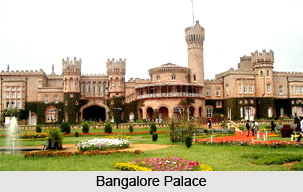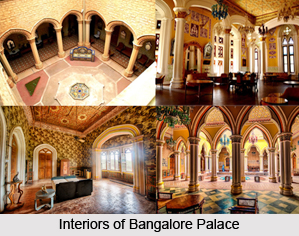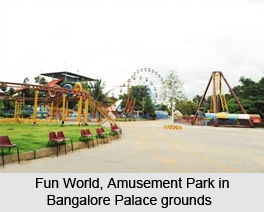 Bangalore Palace is a palace located in the capital city of Bengaluru, Karnataka. Its construction was started in 1862 and completed in 1944. Designed on the lines of the Windsor Castle in England, it was constructed by Rev. J. Garrett, the first principal of the Central High School in Bangalore, which is now known as the Central College. In 1884, Chamarajendra Wadiyar X, the then Maharaja of Mysore, bought this palace. The palace, today is owned by the Mysore royal family and has recently undergone a renovation.
Bangalore Palace is a palace located in the capital city of Bengaluru, Karnataka. Its construction was started in 1862 and completed in 1944. Designed on the lines of the Windsor Castle in England, it was constructed by Rev. J. Garrett, the first principal of the Central High School in Bangalore, which is now known as the Central College. In 1884, Chamarajendra Wadiyar X, the then Maharaja of Mysore, bought this palace. The palace, today is owned by the Mysore royal family and has recently undergone a renovation.
History of Bangalore Palace
The Bangalore Palace was built by Rev. J. Garrett, the first principal of the Central High School in Bangalore, with a floor area of 45,000 square feet (4,200 square metres). The palace along with the grounds surrounding it is spread across a total area of 454 acres (183 hectares). The British officials who were in charge of the education of the young prince Chamarajendra Wadiyar, bought the palace in 1873 AD from Rev. Garrett at a cost of Rs. 40,000, and later renovated it. In 1970, Jayachamarajendra Wodeyar is said to have transferred the possession of the property to two companies promoted by a civil contractor by the name Chamaraju. The companies were known as Chamundi Hotels (P) Ltd, for 110 acres of the area and Sree Venkateswara Real Estate Enterprises (P) Ltd, for remaining 344 acres. But on the given date, the companies were yet to be incorporated and neither there was any sale deed. It was a fraudulent transaction, against which the Maharaja`s only son Srikanta Datta Narsimharaja Wadiyar instituted a civil suit. Maharaja Jayachamarajendra Wadiyar died in 1974 and the legal battle continued, while in the meantime, Srikanta Datta Wadiyar gave the possession of 28 acres (110,000 square metres) each along the Ramana Mahasrhi Road to his five sisters namely Late Gayatri Devi, Meenakshi Devi, Kamakashi Devi, Indrakshi Devi and Vishalakshi Devi, in 1983. They are in possession of their respective portions and many events like rock shows, exhibitions, marriages, tennis, cricket, golf and horse academies are conducted in those portions. Srikanta Datta Narsimharaja Wadiyar ultimately compromised with the Chamaraju group in the years 1990 and 1994, getting back his portion of the property including the main palace, except for 45 acres (180,000 square metres) along the Jayamahal Road that is retained by the Chamaraju group. All along, the Government of Karnataka had also been making various attempts to seize the property under Land Acquisition Act, 1894, and Urban Land (Ceiling and Regulation) Act, 1976. Having not succeeded, the government ultimately enacted the Bangalore Palace (Acquisition & Transfer) Act, 1996, under Mr. H.D. Deve Gowda to expropriate the entire premises spreading over 450 acres of prime real estate, for a farthing of Rs.11 Crores. The dispute is pending before the Honourable Supreme Court of India till date, requiring constitutional issues like whether material resources of the community under Article 39(b) of the Indian Constitution covers what is privately owned. The same awaits decision by a 9-Judge Constitution Bench of Indian Supreme Court. A judgment in favour of the government might lead to more such legislations for acquisition of similar properties. This is also alleged to be in contrast to the new Land Acquisition, Rehabilitation and Resettlement Bill, 2013, recently passed by the Indian Parliament.
Interiors and Grounds of Bangalore Palace
The Bangalore Palace, located in the heart of the city of Bengaluru, is encircled with beautiful gardens. The sprawling grounds of the palace are now used for holding musical concerts and other public events. Several rock bands and rock stars have performed here, the likes of The Black Eyed Peas, Sting, Scorpions, Deep Purple, Aerosmith, Backstreet Boys, Elton John, Akon, Metallica, Enrique Iglesias, The Rolling Stones, Bryan Adams, Iron Maiden, amongst other international artists. The palace grounds are also exotic wedding venues, with a number of private companies controlled by the royal family running a number of wedding halls on the grounds.
Primarily made of wood, the Bangalore Palace is famed for its carvings and paintings. The palace was built in Tudor style architecture with fortified towers, battlements and turrets. The interiors were ornate with elegant wood carvings, floral motifs, cornices and relief paintings on the ceiling. The furniture, which was neo-classical, Victorian and Edwardian, was bought from John Roberts and Lazarus. The upkeep of the gardens was the responsibility of the horticulturist Gustav Hermann Krumbiegel. A total of 35 rooms were built in the palace with most of them being bedrooms. The renovation by the British after acquisition in 1873 included addition of stained glass and mirrors, specially imported from England, besides a manual lift and wooden fans from General Electric.
The ground floor of the palace consists of an open courtyard with granite seats covered with fluorescent blue ceramic tiles. The ground floor also has a ballroom for holding private parties. On the first floor is the Durbar Hall, accessed by climbing a decorated staircase. This is a sprawling hall where the king used to address the assembly. The walls along the staircase are adorned with paintings and the Durbar Hall has a massive elephant head mounted in it. One side of the hall contains stained glass windows in Gothic style. The yellow colour is used profusely on the walls and the sofa set in the hall. A screen on one end separates the area where the ladies used to sit and watch the assembly proceedings in relative privacy. In this hall, there are several paintings of Raja Ravi Verma. The inside walls of the palace are decorated with some mid-19th century paintings and some Greek and Dutch paintings, a dining table which belongs to the Diwan of Mysore, containing a mother-of-pearl inlay with Chinese lacquer work.
Renovation of Bangalore Palace
The Bangalore Palace underwent renovation for the purpose of maintaining the historically relevant architecture, initiated by the owner Srikanta Datta Narsimharaja Wadiyar. The woodwork and the ballroom were redone. The brass fittings and lamps have also been replaced and the furniture has been newly upholstered. Out of the collection of 30,000 photographs currently present in the palace, it is planned that about 1,000 of them will be restored and put up for viewing in an exhibition. A room has been converted into a boutique where silks and other garments used by the royal family will be exhibited. The palace is open to the public who can visit it after paying a nominal fee. There are also plans to rent out the ballroom for private parties and to sell silk scarves, photographs and other articles used by the royal family to tourists. Illumination of the palace and renovating the gardens using Mexican grass has been in progress.
Related Articles:
Palaces of India
Chamarajendra Wadiyar X
Mysore
History of Mysore
Wodeyar Dynasty, Mysore
Jayachamarajendra Wodeyar
Srikanta Datta Narsimharaja Wadiyar
Neo-classical Architecture in India
Raja Ravi Varma, Indian Painter



















